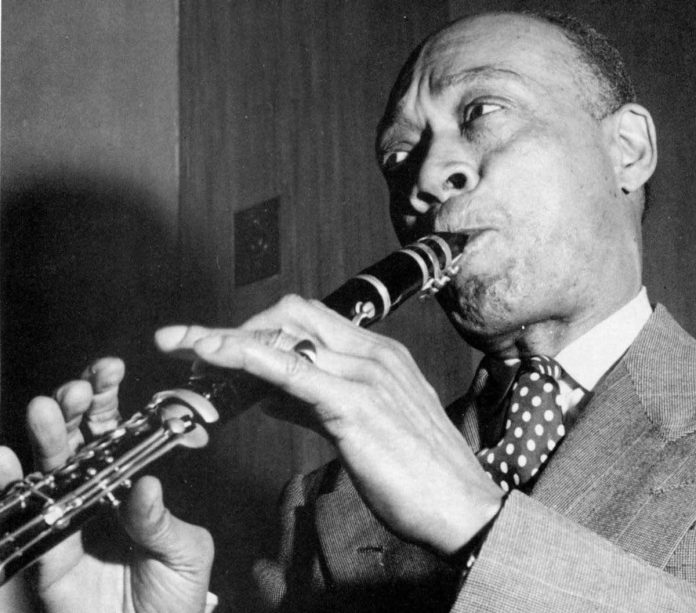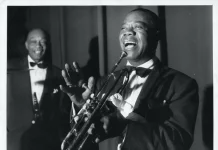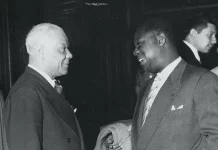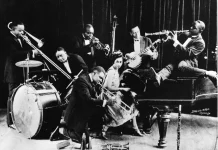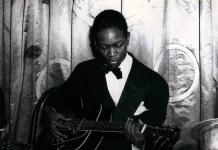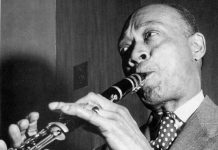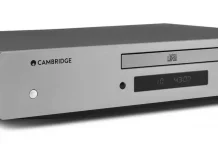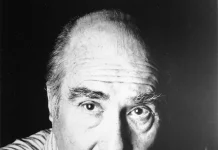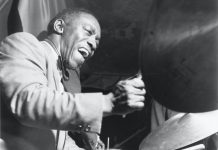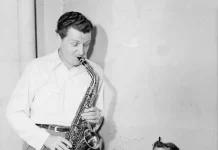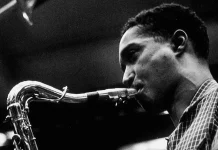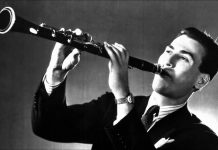There’s a good case for claiming that the Vic Dickenson Septet date of 29 December 1953 is one of the finest jazz recordings ever made – like every other jazz recording it isn’t perfect. The 10” LP that resulted was the first issue over here of the American Vanguard label – a label with honour, if ever there was one.
On that day Ruby Braff on cornet, Edmond Hall, clarinet and Vic on trombone came together with pianist Sir Charles Thompson, bassist Walter Page and drummer Les Erskine to produce one of the most relaxed studio sessions that ever happened. John Hammond, who seemed to regard himself as officer class amongst the jazz musicians’ ranks and was often officious, must be credited with creating, on this occasion, the exalted mood.
Dickenson, always imaginative but often erratic, soloed this day in a sublime fashion that he probably never bettered on disc. Edmond Hall, who by the early 50s had matured to both his most lyrical and most waspish, showed in his solos here a step forward in sophistication from the ones he had been able to record with Condon.
Always an energetic player, Hall had begun the 50s with a new eloquence, up till then displayed at his best in the session of 8 March 1951 with George Wettling’s band (actually the Condon band in all but name) on a Columbia 10” LP. The eight tracks fitted snugly onto the new medium. There’s a case for looking at Ed Hall’s output for these years, because it was unfailingly brilliant. Ed, as well as being with Pee Wee Russell the hottest clarinet in Chisago style jazz, was also, when he combed his hair, the perfect New Orleans clarinettist. And there were such a lot of them – Sidney Bechet, Jimmy Noone, Barney Bigard and Ed right back to the less cosmopolitan classicists such as Alphonse Picou and Albert Burbank, with dear old George Lewis modestly in between. At round the time of the Vanguard session Ed had been an established Condon voice for several years.
If you dig into his history you will find that he was playing great jazz in New Orleans throughout the years of the First World War. Ed worked as a teenager (he was born in 1901) with the great New Orleans cornettist Chris Kelly, one of the young players who had carved the teenage Louis Armstrong without realising what was to come.
And it wasn’t just him. His brothers Herbie and Robert played similar clarinet and Edward played tuba. Clarence played tenor in traditional New Orleans bands and went on to be a noted R&B player.
But they were all in Edmond’s shadow. Ed played in a wide variety of bands, spending years with Claude Hopkins, and rising during the war years to have a quartet with Teddy Wilson as his pianist. One of the greatest Mosaic boxes (well, two boxes) contain the entire Commodore label catalogue, and Ed’s to be found in good stuff on the second box, with both his own quartet and with a 1944 George Wettling band with Billy Butterfield.
The Dickenson Septet was to take a new advantage from the LP form, for Hammond told his men that there was no limit to the length of their tracks. As so often, the “jam session” was claimed to be made without forethought, and as always the claim was a fib in that the number of choruses, key changes and so on all had to be determined in advance. Nonetheless, the septet’s improvising and their ideas were obviously as spontaneous as could be, and what few collective ensembles there were had an unusually good equilibrium and led to elegant collective codas.
Ruby Braff claimed that this was the first decent recording session that he’d ever been on. It should be remembered that since Ruby was then regarded as some kind of likely assassin not a lot of people invited him to play on their dates.
And, talking of assassins, here’s a disruptive diversion.
“Because they invented jazz, the world thinks that only black musicians can play it. Even jokers like Buddy Tate and Vic Dickenson. Vic Dickenson couldn’t blow his nose.”
The speaker was trumpet player Al Porcino, on the phone from his home in Munich to the bassist Red Kelly in 1992. By that time Porcino had been living in the German city for 15 years. Born in New York on 14 May 1925, he died after a fall in Munich on 31 December 2013.
Porcino’s jazz credentials were impeccable. As one of the greatest lead trumpeters ever, he began playing professionally in 1943 and worked with the bands of Louis Prima, Tommy Dorsey, Charlie Barnet, Woody Herman, Stan Kenton, Gene Krupa, Chubby Jackson, Terry Gibbs, Buddy Rich, Thad Jones-Mel Lewis and Count Basie as well as leading his own obscure but dazzling big band to accompany Mel Tormé and a variety of singers. He also did limitless work in the studios. He reserved his admiration mainly for musicians of Italian extraction. His conversation with Red Kelly displayed an unusually intense set of prejudices.
“I saw Clifford Brown in Berlin when I was there with the Kenton band. He was using a home-made mouthpiece. If he’d have lived he’d have been the premier trumpet player after Dizzy. Dizzy’s very ill now because he works too hard. He played more than 200 concerts last year. I’ve always said that Dizzy was the greatest.
“Miles Davis? A joke and a disgrace. He was fine when he began, but what he’s doing now is a joke and a disgrace. And I see he got $80,000 for one concert in Europe. A joke and a disgrace. I saw Barry Harris, too. He’s like Conte Candoli, he’s got that wonderful sense of time and taste. Only a few musicians have that – Carl Fontana, Sal Nistico.
“It’s all the fault of the record companies and the critics. If you like Miles Davis and Duke Ellington you’re hip. Of course I don’t want to talk about the black and white thing because I could go on for hours about that.
“Critics and disc jockeys and the whole world are so brainwashed. Because the black players invented jazz, they’re the only ones that can play it, even if it’s a joker like Buddy Tate or Vic Dickenson. Vic Dickenson can’t blow his nose. They walk out of there if it’s a white guy that’s playing. They’re all screaming discrimination but the fact is the most discriminated-against group is white jazz musicians. You can thank guys like John Hammond, Leonard Feather and George Simon. Check record catalogues and jazz festivals – you’ll find 90 to 100 per cent black musicians.”
There’s a lot more, but I think I need a rest.

